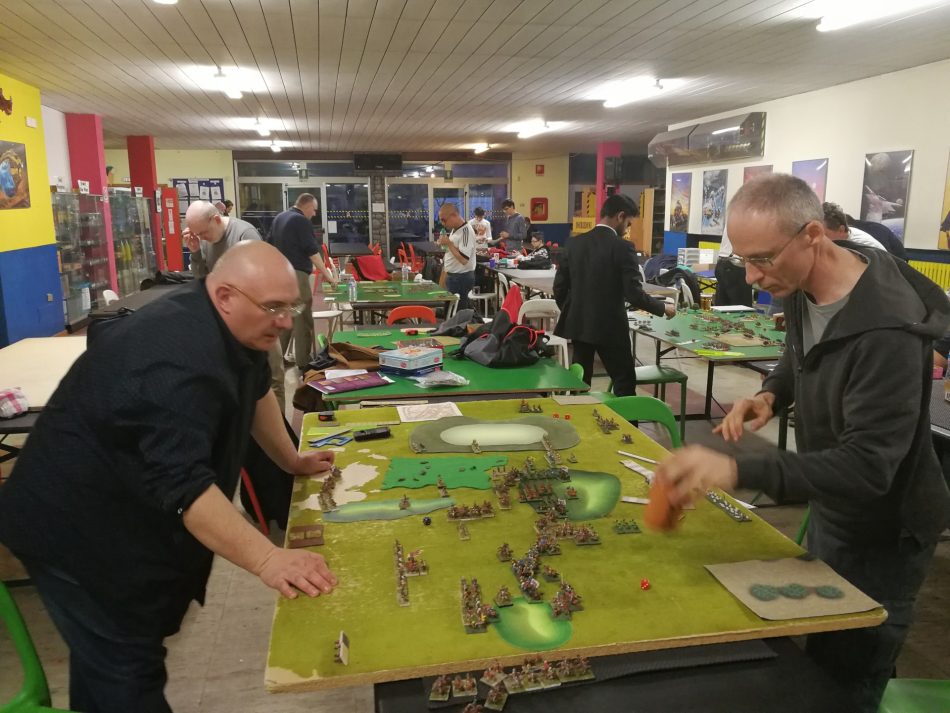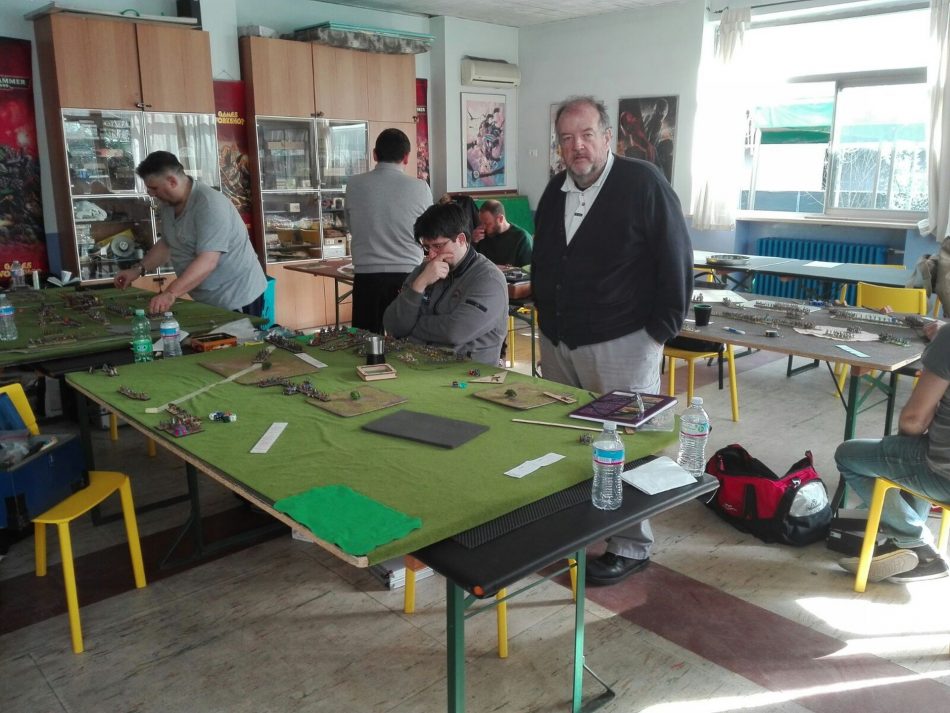DBMM, how does it work
Over four thousand years of global warfare, from the sunny deserts with chariots clashes in the biblical period to the medieval reigns and countries battling each other for some religion or succession wars: there aren’t many rulesets so ambitious to even try to simulate battles with such an immense time span, from Kadesh to Cerignola. tries and succeeds in creating a wargame system that is both historical and fun, albeit not that easy to read. Let’s see how it works.
DBMM, the basics
To play DBMM, you need some d6s, a ruler in centimeters and an army. You can play with 28mm soldiers, but I think DBMM, for his grand scale, works better with 15mm. If you place two DBMM cavalry bases one after the other, the area covered by these two bases is similar to a football field, if you want to get an idea. With a 400 army point, the standard we’ve been using since the first DBM version, you can have fairly satisfying games and you can play on a normal ping pong tablet (1.80 x 1.20 meters).
Each of the 380 (circa) army lists have an incredible historical accuracy, inherited from when DBM was the ruleset published from WRG in early 90ies. Despite the vast majority of the lists are only one page long, you can find all the lists you can desire from history: lots of Romans, each with their sub-period or geographical specific lists, from the Polybians to the Patrician, but also relatively unknown armies like Bythinians, Hussite rebels with their chained war wagons, the Aztec from the pre-Colombian Americas or the Wallachian list led by the general who inspired the myth of Dracula!. If existed in history and somebody reported about them, you can be pretty confident they are in the four DBMM army list books.

DBMM key elements
There are three key elements in DBMM. the first is a huge simplification for the troop types. For example, the type “Blade” type refers to Roman Legions, but also to the dismounted medieval Knights or the Vikings huscarls. So you don’t have dozens of heavy infantry types you could expect from a ruleset spanning from 3000 BC to 1500 AD, but only four. Spears, the kind for Greek Hoplites, but also Communal troops; the above-mentioned Blades for close combat sword-wielding troops.
The Warbands, including all foot troop charging recklessly against any enemy, and finally the Pike troops, including all infantries with long pikes from the Macedonian Phalanx to the Swiss medieval army. For the mounted troops, you have a similar situation: Light horses (anything for Scythians to Huns), Cavalry (think to Roman mounted without stirrups) and Knights type. To complete the troop type range, we have Artillery and WarWagons, Elephants, the very few Shots (infantry with shooting devices), Auxilia and Psiloi for the footlight troops, as well as few naval you won’t use so easily.

However, for each unit, you have other two layers of detail. A unit can be regular or irregular: this grade will affect if they can do difficult movements on the field, especially at a tactical level. Then, each unit can be Ordinary (the majority of the troops), Inferior or Superior (either if they are sensibly worse or better than the average).
The Fast type is like ordinary, but they can move a bit faster giving up to some resistance and endurance in combat. The special “X” type is for all eXceptions. For example, the Elephant (X) is specific for the artillery mounted on Khmer elephants, while Kn(X) defines the heavy cavalry with all horse body covered by chainmail, really good against bow shooting but weak when charged by another lance-armed cavalry, like Tibetan or Byzantine ones.
 Two players in the final stages of a DBMM game: the Catalan army surrounded the enemy camp.
Two players in the final stages of a DBMM game: the Catalan army surrounded the enemy camp.
The second key element for DBMM is how you can give orders to your troops. The size of the battle you’re going to fight is similar to Cannae, with as much as 50.000 soldiers for each side: so you can’t really think to have a capillary chain of command like in modern wars. Wargames normally use an overly complex system to simulate the orders sent and received, taking in account messengers reliability, the ability to fully understand orders, the eventuality the horseman taking the orders is killed or captured, and so.
DBMM uses a PiP system that at first glance will seem ingenuous or even naif. At the start of any bound, you just roll a d6 for each command, and the result is the number of orders you can give in that round – simple and clear.
Obviously, it’s a simulation: but the huge amount of work and experimentation on how these PiPs are spent is the key for a very balanced simulation, easy to learn but at the same time giving very good and historically consistent situations and results.
 A typical DBMM engagement: you can see the “recoil” effects on the right, and the “overlap” on the fight on the left.
A typical DBMM engagement: you can see the “recoil” effects on the right, and the “overlap” on the fight on the left.
For example: meet the regular Blade Ordinary (in DBMM terms, we would write “rBd(O)”). It’s a legionary detachment. If you move the Bd frontally, you spend 1 PiP, the same as if the Bd would be an Irregular band of Viking raiders. But if you want to move the Bd laterally or retire it backward, the Legio would pay again only 1 point, while the iBd(O) of Viking nature would spend 2 PiPs. Add that a regular general like the Roman one would normally throw three same colour dices and give the highest one to the command he wants to move better, while the Viking leader will throw three different dice and will always give the red one to the left wing, the blue to the right and the green to the center, narrowing the control on his troops.
Finally, the third key element I really like in DBMM, Lots of games ask you to track down the losses in each unit, or to keep record if a single unit is shaken or demoralized. You also need to do a lot of math to count if the 1.000-strong Legio unit lost 100 men or 200 in the last melee phase. In DBMM, you have – again – a very easy system, but able to achieve deep results. Each unit has a basic fighting value against infantry/train and another one versus mounted. So, when a Bd(O) fights another Bd(O), it’s a plain 4 vs 4. You roll a dice and your opponent does the same, and you add those results to the basic value. Let’s say the Roman rolls 4 and the Viking rolls 3. The total is 8 vs 7, so the Viking Blade is pushed back, resulting in a “recoil”. To kill each other, you need to have a double value – 10 vs 5, that on a single combat can be achieved only if you roll a 6-1. Really awkward, at first glance.
However, if you think that a full Roman army is fighting a battle with a consistent Viking landing party, you will probably have a long line of 10 rBd(O) fighting a similar long line of iBd(O). So, after the first fight, resulting in a recoil, the next one would be 4 vs 3, since the Vikings have an uncovered flank (we call that an “overlap”), resulting in a -1. Now the Roman needs to roll “only” a 4 vs 1 to kill the Viking (8 vs 4). Much better and much more likely to happen compared to a 6-1 result.

But the DBMM system has another layer: any good wargame creates the scissor-paper-rock mechanic, where a unit is very good against another type, and weak vs another. In DBMM this is made not only by the values but with the “quick kill” ability.
Some troops can kill much more easily some other troops. For example, Knights (the type of troops including all medieval knights, but also the Byzantine Clibanari, the Alexander Companions, and the Assyrian heavy chariots) have the quick kill ability against all infantry troops. If a Kn is fighting a Bd, for example, it just needs to have +1 on the final results. So. they start from 4 vs 4 (their basic value) and add the dice. If the Knights roll a 4 and the Blade a 3, the Blade is immediately removed.
The Morale system
Finally, you don’t have to kill all enemy troops. When you deploy your army, you divide your troops into three or four “commands”. To determine the level of the morale of a command, you count “2” for the most important troops (like the Knights, the Elephants, the Guards, and so), “0,5” for the Psiloi and other very light troops, and “1” for all other units. For a soldier, to march near the Infantry Guard or the mighty Knights Hospitaller was a source of motivation, while a light slinger added little account in his morale. At the same time, he could expect to lose some slinger in the battle, but seeing a knights detachment killed by enemy Elephants would be a terrifying sight for his morale.
 Your army will have a “Camp” to defend: it gives a huge boost to your army morale, but if the enemy destroys it could be a game-changer. Lots of players try to have a good looking 12 x 8 cm camps, like this destroyed ancient temple.
Your army will have a “Camp” to defend: it gives a huge boost to your army morale, but if the enemy destroys it could be a game-changer. Lots of players try to have a good looking 12 x 8 cm camps, like this destroyed ancient temple.
So, if the Command total morale is 21, the command loses the same values if the enemy kills your troops: 2 for Knights and Elephants, 1 for the humble Spear, 0,5 for the light slinger. If the Command loses more than one-quarter of the total Morale, it becomes “disheartened”: in the next bounds, it will suffer a -1 on all fights, and maluses for moving the troops toward the enemy. If the command loses more than one third, it becomes totally demoralized: you can only try to keep the units in position (or the will fall back), and all the Command Morale is counted as lost. If an army loses half the total Morale of its commands, the game is over.
These are the basics for DBMM. In the next article, we will see full DBMM battle, and how the rules are applied.
Editor note: Discuss this game, ask questions or share your own DBMM experiences, or photos on

Nice to know its still being played and not everyone has gone to ADLG or MeG .